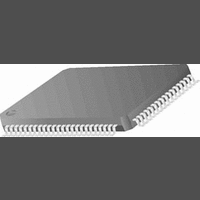CR16MCS9VJE8 National Semiconductor, CR16MCS9VJE8 Datasheet - Page 87

CR16MCS9VJE8
Manufacturer Part Number
CR16MCS9VJE8
Description
16-Bit Microcontroller IC
Manufacturer
National Semiconductor
Datasheet
1.CR16MCS9VJE8.pdf
(156 pages)
Specifications of CR16MCS9VJE8
Controller Family/series
CR16X
Core Size
16 Bit
Program Memory Size
64K X 8 Flash
Digital Ic Case Style
PQFP
No. Of Pins
80
Mounting Type
Surface Mount
Clock Frequency
25MHz
Lead Free Status / RoHS Status
Contains lead / RoHS non-compliant
Available stocks
Company
Part Number
Manufacturer
Quantity
Price
Company:
Part Number:
CR16MCS9VJE8
Manufacturer:
ON
Quantity:
8 917
Company:
Part Number:
CR16MCS9VJE8-CBB
Manufacturer:
ON
Quantity:
846
Company:
Part Number:
CR16MCS9VJE8-CBC
Manufacturer:
ON
Quantity:
109
Company:
Part Number:
CR16MCS9VJE8-CBD
Manufacturer:
ON
Quantity:
17
Company:
Part Number:
CR16MCS9VJE8-CBE
Manufacturer:
ON
Quantity:
1 950
20.2
This section provides a generic overview of the basic con-
cepts of the Controller Area Network (CAN).
The CAN protocol is a message based protocol that allows a
total of 2032 ( = 2
format and 512 million ( = 2
extended frame format.
Every CAN Frame is broadcasted on the common bus. Each
module receives every frame and filters out the frames which
are not required for the module's task. For example, if a
dashboard sends a request to switch on headlights, the CAN
module responsible for brake lights must not process this
message.
A CAN master module has the ability to set a specific bit
called the “remote data request bit” (RTR) in a frame. Such a
message is also called “Remote Frame”. It causes another
module, either another master or a slave which accepts this
If a data or remote frame loses arbitration on the bus due to
a higher-prioritized data or remote frame, or if it is destroyed
by an error frame, the transmitting module will automatically
retransmit it until the transmission was successful or the user
has canceled the transmit request.
If a transmitted message loses arbitration, the CR16CAN will
restart transmission at the next possible time with the mes-
sage which has the highest internal transmit priority.
20.2.1
Communication via the CAN bus is basically established by
means of four different frame types:
— data frame
— remote frame
— error frame
— overload frame
CAN Frame Formats
BASIC CAN CONCEPTS
11
-16) different messages in the standard
BUS LINE
29
-16) different messages in the
RECESSIVE
DOMINANT
MODULE A
MODULE B
Figure 45.
RxPIN
RxPIN
TxPIN
TxPIN
MODULE A SUSPENDS TRANSMISSION
CAN message arbitration
87
remote frame, to transmit a data frame after the remote
frame has been completed.
Additional modules can be added to an existing network with-
out a configuration change. These modules can either per-
form completely new functions requiring new data, or
process existing data to perform a new functionality.
As the CAN network is message oriented, a message can be
used as a variable which is automatically updated by the con-
trolling processor. If any module cannot process information,
it can send an overload frame.
The CAN protocol allows several transmitting modules to
start a transmission at the same time as soon as they monitor
the bus to be idle. During the start of transmission, every
node monitors the bus line to detect whether its message is
overwritten by a message with a higher priority. As soon as a
transmitting module detects another module with a higher
priority accessing the bus, it stops transmitting its own frame
and switches to receive mode. For illustration, see Figure45.
Data and remote frames can be used in both standard and
extended frame format. If no message is being transmitted,
i.e., the bus is idle, the bus is kept at the ‘recessive’ level.
Remote and data frames are non-return to zero (NRZ) coded
with bit-stuffing in every bit field, which holds computable in-
formation for the interface, i.e., start of frame, arbitration field,
control field, data field (if present) and CRC field.
Error and overload frames are also NRZ coded but without
bit-stuffing.
After five consecutive bits of the same value (including insert-
ed stuff bits so that the stuffed bit stream will not have more
than five consecutive bits of the same value), a stuff bit of the
inverted value is inserted into the bit stream by the transmit-
ter and deleted by the receiver. The following shows the
stuffed and destuffed bit stream for consecutive ones and ze-
ros.
www.national.com











